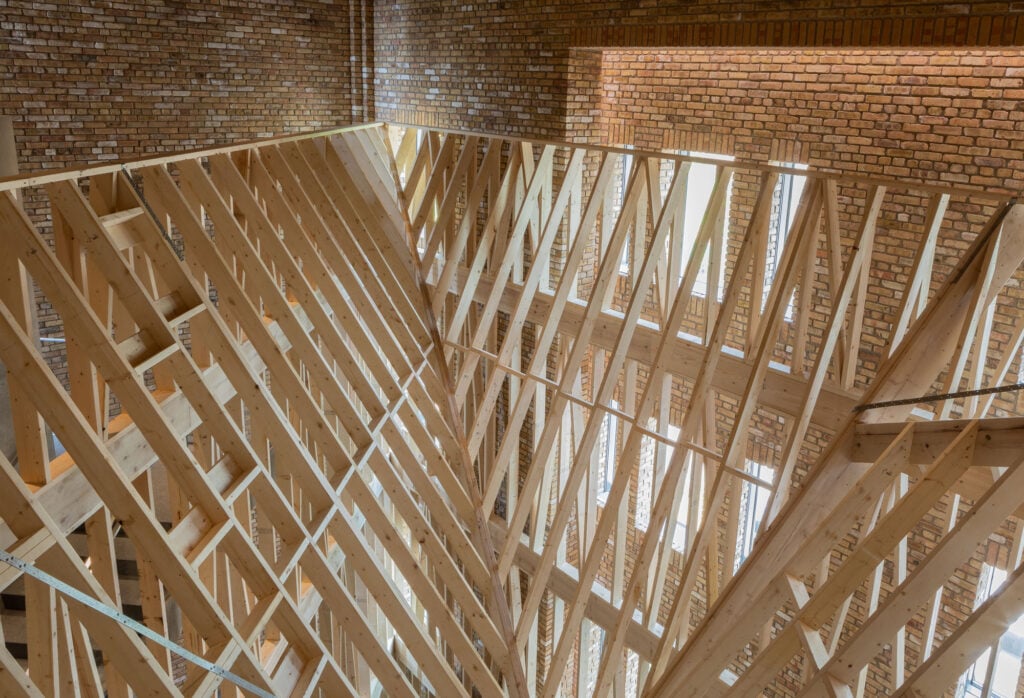
November 6, 2024
How Construction Materials and Technologies Are Evolving
Circularity in Construction
Circularity in construction reshapes the industry by prioritizing the reuse, recycling, and repurposing of materials to minimize waste and environmental impact. Some people, like Felix Haisel, assistant professor at Cornell University College of Architecture, Art, and Planning, are working to shift the focus from linear to circular thinking about material consumption with the Circular Construction Lab. Others, like Shannon Goodman, former Perkins&Will architect, helped develop a coalition like ReBuildATL and cofounded the Lifecycle Building Center to break these systemic barriers and keep reusable materials out of landfills. Finally, many people like Sydney Mainster, designer and director of sustainability at the Durst Organization, and Blaine Brownell, architect and editor of the Transmaterial book series found different ways to repurpose demolition building materials like concrete and glass to help reduce overall building waste.
Read more in the following articles:
Circularity
Next-Gen Construction Technologies
Next-generation construction technologies are revolutionizing the industry, introducing groundbreaking solutions that streamline processes and redefine the way we build. For example, METROPOLIS Future100 honorees like Chizumi Kano from California College of the Arts, and Andrea Rubero from Rice School of Architecture, found inventive ways to apply natural building materials to create sustainable and culturally attuned projects. Meanwhile, technologies from major brands like Lumion, Nix, and Caesarstone are highlighting the versatility of materials in the built environment. On the other hand, architecture teams like Foster + Partners and the University of London are creating free, open-source technologies to fill gaps in today’s software offerings. Finally, Material Bank, the world’s largest marketplace for those seeking architectural, design, and construction materials, acquired Architizer in hopes of aiding architect users and architectural product manufacturers.
Learn more about next-gen construction technologies here:
New Tech
Creative Concrete
Today, manufacturers and architects are exploring innovative alternatives that transform concrete and cement to contributors to global sustainable design and construction. Some of these concrete products rely on recycling concrete itself, while others cultivate new, less energy- and carbon-intensive recipes. For example, Biomason and GXN’s Biocement uses non-modified bacteria to grow a cement-like material, while Brimstone created a cement using carbon-free calcium silicate rock. Over in Germany, researchers at the Dresden University of Technology, created the “Cube,” the first building made of carbon-reinforced concrete, which is stronger, lighter and customizable. Similar to that note, WRNS Studio revamped Okland Construction’s Salt Lake City office with a board-formed concrete material that blends natural lumber and a ready mix together. Finally, ETH Zurich’s HiLo building is constructed of a sustainable concrete design blending medieval construction techniques with digital fabrication technology.
Delve deeper into stories about creative concrete:
Concrete
The Past and Future of Timber
From its roots in traditional building practices to its emergence as a sustainable solution for modern construction, mass timber is bridging the past and future of architecture with eco-friendly innovation. Take ZGF Architects’ revamp of the Portland International Airport with its nine-acre prefab wood roof, tree-lined terminal and multiple skylights bringing in natural light to the facility. Not only did it bring more attention to an already beloved airport, but it became a new milestone for mass timber. Meanwhile, Chicago Wrightwood 659 Gallery’s exhibition “American Framing,” brought attention to softwood lumber construction and how it can continue to evolve in the building industry. Finally, resource professionals like Kenn Busch conducted multiple focus groups and conversations with A&D specifiers to answer questions about obtaining sustainable wood in the United States, in hopes of showing the impact of forest products.
Read more about the past and future of timber here:
Timber
Innovations in Modular Construction
Innovative advancements in modular construction are transforming the way buildings are constructed, enabling scalable and more sustainable solutions for modern housing projects. For example, take KTGY Architecture + Planning’s “drop and lock” prefab technique, which allows parts to be fabricated off-site, and has been used to create affordable housing developments like Hope on Alvarado in Los Angeles. Also in the Los Angeles area, firm Studio One Eleven used shipping containers to create the development Watts Works, a community of 24 studio apartments that is working to reshape the underbuilt affordable housing sector. Meanwhile, across the country in New York, Liv-Connected’s design-forward units are also helping redefine modular housing and offer more affordable options for the city.
Learn more about innovations in modular construction:
Modular Construction
Conclusion
As construction materials and technologies continue to evolve, they are driving innovation and reshaping the future of the industry. By embracing sustainable solutions, advanced manufacturing techniques, and cutting-edge technologies, the construction sector is poised to deliver more efficient, durable, and eco-friendly projects. Staying ahead in this dynamic landscape requires a commitment to continuous learning and adaptation, ensuring that the structures we build today meet the challenges of tomorrow.
Would you like to comment on this article? Send your thoughts to: [email protected]
Other Guides from METROPOLIS
Viewpoints
A Guide to Circularity in Products
METROPOLIS rounds up its most compelling coverage of circular design in products, from rethinking plastic production to salvaging used materials.
Viewpoints
Navigating the Path to Net Zero
METROPOLIS mines its archives for pioneering perspectives and projects that prove the possibilities of net zero design.
Viewpoints
What Architects and Designers Need to Know About Embodied Carbon
From complex topics such as carbon form to advice on how to specify carbon-neutral furniture, METROPOLIS provides a lay of the land for carbon and design.






















